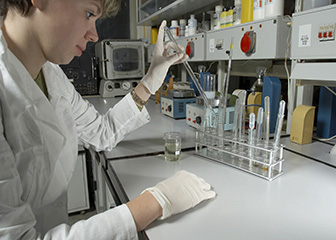What Chemists and Materials Scientists Do
About this section

Most chemists and materials scientists work as part of a team.
Chemists and materials scientists research and analyze the chemical properties of substances to develop new materials, products, or knowledge.
Duties
Chemists and materials scientists typically do the following:
- Plan and carry out research projects, such as development of products and of testing methods
- Direct technicians and other staff in chemical processing and testing, including for ingredients, mixing times, and operating temperatures
- Collaborate with engineers and other scientists on experiments, product development, and production processes
- Prepare solutions, compounds, and reagents used in laboratory procedures
- Analyze substances to determine their composition and concentration of elements
- Conduct tests on materials and other substances to ensure that safety and quality standards are met
- Write technical reports that detail methods and findings
- Present research findings to scientists, engineers, and other colleagues
Chemists and materials scientists work usually work in either basic or applied research. In basic research, chemists and materials scientists investigate the properties, composition, and structure of matter. They also experiment with combinations of elements and the ways in which they interact. In applied research, chemists and materials scientists investigate developing new products or improving existing ones, such as medications, batteries, and cleaners.
Chemists and materials scientists use computers and other laboratory equipment for modeling, simulation, and analysis. For example, chemists may use three-dimensional modeling software to study the structure and properties of complex molecules.
Most chemists and materials scientists work as part of a team that may include physicists, microbiologists, and engineers. For example, chemists in pharmaceutical research may work with biochemists and biophysicists or chemical engineers to develop new drugs and with industrial engineers to design ways to mass-produce the drugs.
Chemists may work in interdisciplinary fields, such as biochemistry or geochemistry. They also may specialize in a particular field. The following are examples of types of chemists:
Analytical chemists identify elements and compounds in a substance to determine its structure, composition, and nature. They also study the interactions between parts of compounds. Some analytical chemists specialize in developing new methods of evaluation. Their research has a range of applications, including food safety and pollution control.
Forensic chemists aid in criminal investigations by testing and analyzing evidence, such as DNA. These chemists work primarily in laboratories but may testify in court as expert witnesses to explain the results of their analyses.
Inorganic chemists study the structure, properties, and reactions of substances that do not contain carbon, such as metals. They work to understand the behavior and the characteristics of inorganic substances, such as ceramics and superconductors, for modifying, separating, or using in products or for other purposes.
Medicinal chemists research and develop chemical compounds to create and test new drug products. They also help develop and improve manufacturing processes to effectively produce new drugs on a large scale.
Organic chemists study the structure, properties, and reactions of molecules that contain carbon. They also design and make organic substances for use in developing new commercial products, such as medicine and plastics.
Physical chemists study how matter behaves and how chemical reactions occur. From their analyses, physical chemists may develop theories, such as how complex structures are formed, and research potential uses for new materials.
Theoretical chemists investigate abstract methods that predict the outcomes of chemical experiments. Their specializations may incorporate different branches of computer science, such as artificial intelligence. Some examples of theoretical chemists are computational chemists, mathematical chemists, and chemical informaticians.
Materials scientists typically specialize in the material they work with most often. Examples include ceramics, metals, polymers, and semiconductors.
 United States Department of Labor
United States Department of Labor












